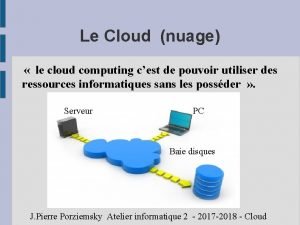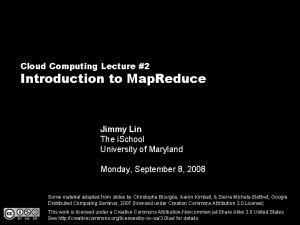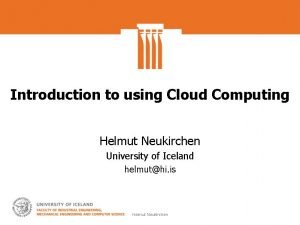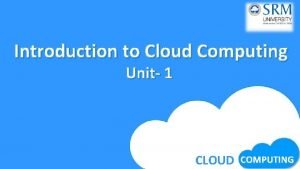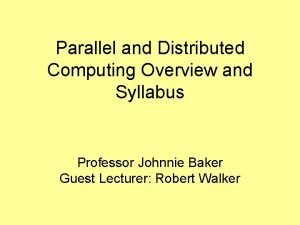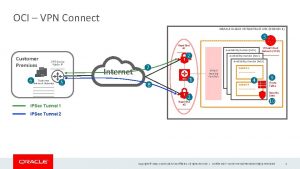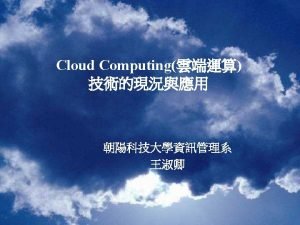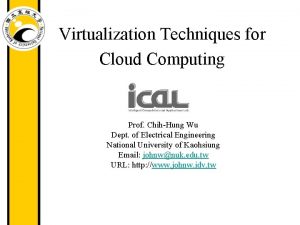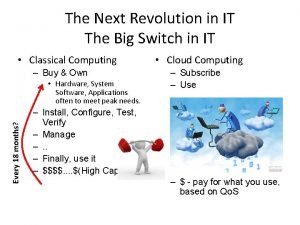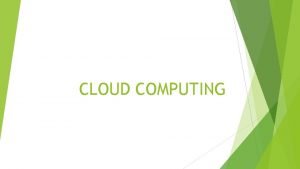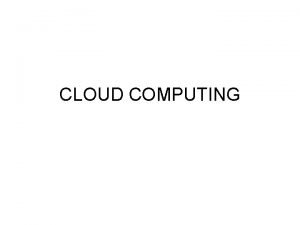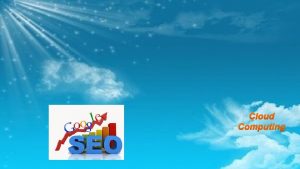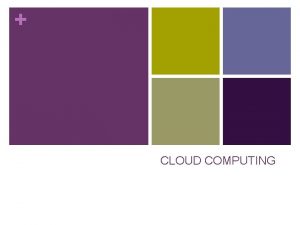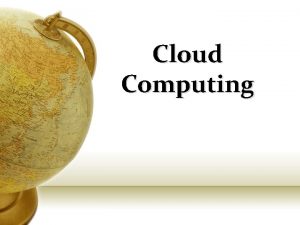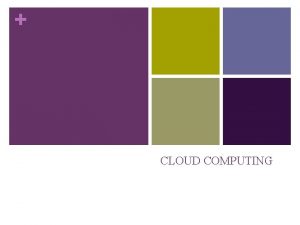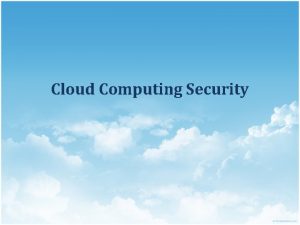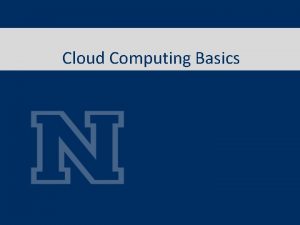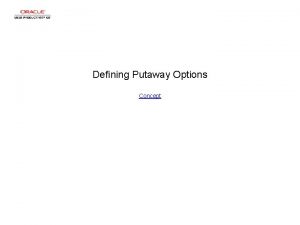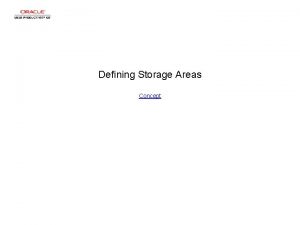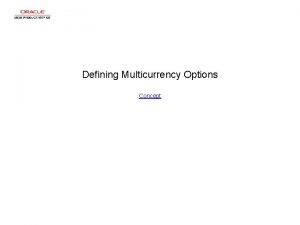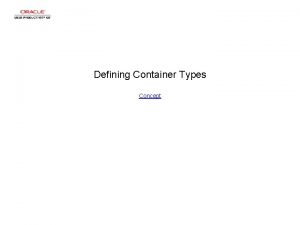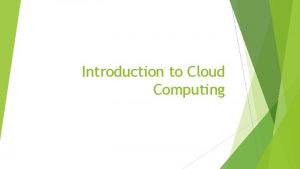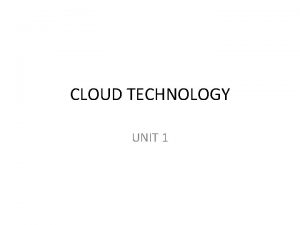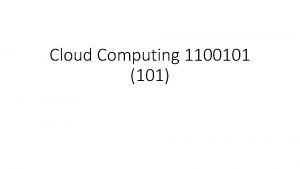Introduction to Cloud Computing Outline Defining Cloud Computing




















- Slides: 20

Introduction to Cloud Computing

Outline § Defining Cloud Computing § Evolution of Cloud Computing § Characteristics of a Cloud § Cloud Computing Architecture § Cloud Services: Iaa. S, Paa. S, Saa. S § Pros and Cons § Public Clouds and related resources 2

What is Cloud Computing? NIST Definition “A model for enabling ubiquitous, convenient, on-demand network access to a shared pool of configurable computing resources that can be rapidly provisioned and released with minimal management effort or service provider interaction. ” 3

History 4

Evolution of Cloud Computing 5

Evolution of Cloud Services 6

Components of the Cloud § Front-end (regular desktop, thin client, mobile device) § Back-end (servers) § Storage / Datacenters § Delivery Service (Saa. S, Paa. S, Iaa. S) 7

Service Models (Saa. S) § Saa. S – Software as a Service Network hosted application; consumers purchase the ability to access and use the application; consumer cannot manage or control the underlying cloud infrastructure § Examples • Google Apps • Sales. Force CRM 8

Service Models (Paa. S) § Paa. S – Platform as a Service Consumer has the ability to deploy their own applications onto the cloud infrastructure; consumer cannot manage or control the underlying cloud infrastructure § Examples • Google App Engine • Force. com (Sales. Force Dev Platform) 9

Service Models (Iaa. S) § Iaa. S – Infrastructure as a Service Consumers has the ability to provision processing, storage, networks, and other fundamental computing resources; consumer cannot manage or control the underlying cloud infrastructure but can control the operating systems, storage and deployed applications § Examples • Amazon EC 2 10

More Service Models § Daa. S – Data as a Service Consumer queries against provider’s database § Naa. S – Network as a Service Provider offers virtualized networks (e. g. VPNs) 11

Deployment Models § Public Cloud infrastructure is provisioned for open use by the general public. § Private Cloud infrastructure is provisioned for exclusive use by a single organization comprising multiple consumers (business units) 12

Deployment Models 13

Deployment Models § Community Cloud infrastructure is provisioned for exclusive use by a specific community of consumers § Hybrid Cloud infrastructure is a composition og two or more distinct cloud infrastructures (public, private, or community) 14

Key Characteristics § On-demand self-service • Users can acquire, configure, and deploy cloud services without requiring human interaction from the service provider § Broad network access • Capabilities are available over the network and accessed through standard mechanisms § Resource pooling • The provider’s computing resources are pooled to serve multiple customers 15

Key Characteristics § Rapid elasticity • Illusion of infinite computing resources available on-demand • Resources can be obtained in any quantity at any time § Measured service • Services priced on short-term basis and released as soon as not needed • Resource usage is monitored, controlled, and reported 16

Advantages of Cloud Computing § Saa. S – easy consumer adoption § Paa. S – good for developers § Iaa. S – complete control of environment and infrastructure 17

Disadvantages of Cloud Computing § Saa. S – limited functionality, no control or access to underlying technology § Paa. S – restricted to whatever is available on the platform and other dependencies § Iaa. S - expensive 18

Benefits § Cost-saving § Scalability, Flexibility, reliability § Ongoing maintenance 19

Challenges § Security and privacy § Lack of standards § Continuously evolving 20
 Non defining relative clause
Non defining relative clause Relative clauses defining and non defining
Relative clauses defining and non defining Oraciones defining y non defining
Oraciones defining y non defining Defining relative clause meaning in telugu
Defining relative clause meaning in telugu Relative clauses where which farkı
Relative clauses where which farkı Essential relative clause
Essential relative clause Seven step model of migration into cloud
Seven step model of migration into cloud Regarder introduction to cloud computing vidéos
Regarder introduction to cloud computing vidéos Introduction to mapreduce in cloud computing
Introduction to mapreduce in cloud computing Introduction to cloud computing
Introduction to cloud computing Introduction to cloud computing
Introduction to cloud computing Sandwich quotation
Sandwich quotation Parallel and distributed computing course outline
Parallel and distributed computing course outline Oracle vpn connect
Oracle vpn connect Outline google cloud
Outline google cloud Conventional computing and intelligent computing
Conventional computing and intelligent computing Vodafone cloud and hosting
Vodafone cloud and hosting Virtualization techniques in cloud computing
Virtualization techniques in cloud computing Structure of virtualization in cloud computing
Structure of virtualization in cloud computing Types of clouds in cloud computing
Types of clouds in cloud computing Cloud computing reference model
Cloud computing reference model







